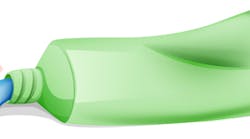Are blue flecks in toothpaste really decorative plastic?
By B. Michelle Strange, RDH, BHS, MSDH
When we pick up a tube of toothpaste, we know that we are holding up an object made from plastic. But when we begin to brush with that minty swirl, we probably are not aware that the same type of plastic that makes the tube is also inside the paste and now inside our mouths.
Four months ago, I began noticing blue specks washing away while I used the Cavitron on my patients. As hygienists, we all know that we can find some interesting things subgingivally, so, at first, I didn’t think much of it. I am a hygienist in a periodontal practice, and I use my Cavitron on every patient after I complete my initial periodontal probing. I can only imagine how often the Cavitron is flushing out these tiny colored flecks before I notice them during scaling.
After I observed the specks more frequently, I logged into Facebook — the keeper of all news and conspiracy theories — and found a blog post discussing the blue flecks on one of the dental hygiene pages to which I subscribe. As the only hygienist in the office, I don’t always get to bounce ideas or findings off another likeminded professional. As I read the blog post, I realized that my concerns were not mine alone.
This post said that the specks were from Crest toothpaste and that they were “decorative” blue plastic pieces. I had to read the post again, because I was stunned at the idea that anything, let alone plastic, was being used as a decorative ingredient in toothpaste. I had to find out more, not only for my patients but also to feed my own curiosity. Although I consider myself an ingredient snob and an environmentally conscious person, I never had thought to look at the ingredients in toothpaste. I was aware that sodium lauryl sulfate caused or exacerbated dry mouths in some of my patients, and that, when I use whitening and tartar control, I experience sloughing of my buccal mucosa, an allergic reaction to toothpaste.1 I try to stay away from these ingredients and inform my patients about them. But outside of those concerns, I hadn’t thought much about what else is in toothpaste.
After a little research, I now feel overly educated on the surprisingly long list of ingredients that make up our toothpastes. One such ingredient is polyethylene, or PE, the most common type of plastic. When I conduct research for articles, I try to focus on peer-reviewed journals or articles with up-to-date references. I did not find much existing research that discussed the effects of PE. The articles that I did find focused on the molecular weight of PE in certain paste but that research didn’t offer much insight for me.
Plastic bags and containers, which never biodegrade, are made of PE. PE also is found in face and body scrubs in the form of tiny beads that add texture and boast exfoliation properties.2 The same ingredient is in our toothpaste, primarily the Crest brand. PE is found in other toothpaste brands but mixed with other ingredients, such as triclosan, zinc citrate, SLS and polyethylene glycol.3 Without a molecular biology background, I was a little out of my element trying to read about these ingredients and understand their composition.
One of the more informative articles I found was from Dentalbuzz.com written by Trish Walraven where she becomes a bit of a scientist and attempts to dissolve these little plastic specks that are in the Crest toothpaste. She could not get them to dissolve after soaking the paste overnight in alcohol and acetone. The fact that hygienists are finding these blue specks subgingivally means that they also are not dissolving in our saliva.
You might wonder what Crest says about these little blue specks. According to Snopes.com, Proctor & Gamble put out a statement saying:
The colored polyethylene (PE) specks used in our oral care products are safe, FDA approved food additives. They are used in chewing gums and are commonly used in toothpastes … There is no evidence from clinical studies or from on-going monitoring to indicate that these particles persist underneath the gumline or cause harm. We've already begun the process of identifying alternatives for use in our toothpaste and the PE specks will be replaced as soon as alternatives are qualified. In addition, we have decided not to introduce microplastic beads into any new product category.4
Walraven mentions that Crest adds PE for color and not to aid in cleaning.2 In other words, there’s no dental reason for PE’s presence in toothpaste, and there is a chance we will see it in our toothpaste for quite some time. My intention for this article is to spark a conversation among hygienists about what we are finding in our practices and to stay informed with the ever-changing ingredients in all dental products. I also hope that we soon will have a better understanding of the long-term effects of having plastic specks in the tooth sulcus.
B. Michelle Strange, RDH, MSDH, is a practicing clinician in a private periodontal office, as well as adjunct faculty at Trident Technical College in Charleston, S.C., and is an education consultant for TePe Oral Health Care Inc. She can be reached at [email protected].
References
1. O'Hehir TE. The simple remedy? Don't use it for a week, in RDH Magazine.
2. Walraven T. Crest toothpaste embeds plastic in our gums, in DentalBuzz.com2014.
3. Skaare A., et al., Skin Reactions and Irritation Potential of Four Commercial Toothpastes. Acta Odontologica Scandinavica, 1997. 55(2): p. 133-136.
4. Snopes.com. Urban Ledgends: Crest 3D White Toothpaste. 2014.






